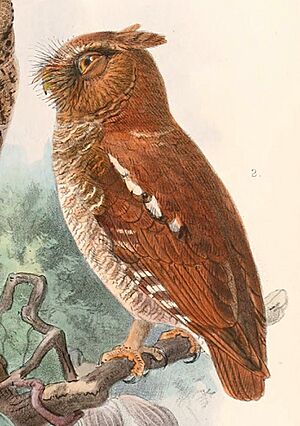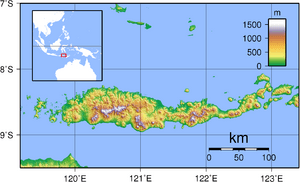Flores scops owl facts for kids
Quick facts for kids Flores scops owl |
|
|---|---|
 |
|
| Flores scops owl | |
| Conservation status | |
| Scientific classification | |
| Genus: |
Otus
|
| Species: |
alfredi
|
The Flores scops owl (Otus alfredi) is a special type of owl that lives only on the island of Flores in Indonesia. It's quite small, about 19–21 cm long, which is like the length of a ruler. These owls live in forests, but their homes are shrinking because of habitat loss. Scientists believe there are only about 250 to 2,499 of these owls left in the wild. This makes them an endangered species.
Contents
What's in a Name?
The Flores scops owl belongs to a group of owls called Otus. This name was first used by a Welsh explorer named Thomas Pennant in 1769. The word "Otus" comes from an old Greek word, "otos," which means "eared owl." This name fits well because many owls in this group have ear-like tufts of feathers on their heads.
How to Spot a Flores Scops Owl
The Flores scops owl is a small and compact bird. It has short, rounded ear-tufts on its head. You might notice white wavy lines on its forehead. Its beak is orange-yellow, and it has long, reddish bristles near its beak, a bit like whiskers.
This owl has a reddish-brown outline around its face. Along the sides of its neck, its feathers are dark reddish-brown with white bases. It also has small white triangles on the back of its neck. Its shoulder feathers have white spots with brown tips. The owl's tail is tiny and hard to see. Its legs are covered in thick feathers, and its claws are a dark orange-yellow color.
Where Do They Live?
The Flores scops owl lives only on the island of Flores in Indonesia. They prefer to live in mountain forests, usually at heights of 1,000 to 1,400 meters. People used to think these owls only lived in wet, semi-evergreen forests in the Flores highlands. However, recent sightings suggest they can also live in drier monsoon forests found at lower altitudes.
Owl Sightings
For a long time, there were only six recorded sightings of the Flores scops owl. These were made by Alfred Everett in 1896. He found three owls in the Todo Mountains in southwest Flores and captured them.
More recently, in 2005, some researchers saw four owls at a place called Danau Ranamese. They spotted them in tall, hidden trees. Later that year, another owl was seen near Danau Ranamese, and one more near Poco Mandasawu.
Even more recently, in 2011, Andrew Hart Reeve and Samuel Rabenak heard and saw these owls. They were at the edge of the Sisok forest, close to Danau Sano Nggoang. They heard the owls calling on September 1, 2011, and then saw them sitting on bamboo branches.
Owl Calls
Flores scops owls make different kinds of calls.
- Single Calls: These are quick, sharp notes that sound like "UH!" They last about 1.5 to 2.5 seconds.
- Territorial Calls: These calls are more common. They are described as a "short burst of loud, rapid staccato notes," sounding like "UH-UH-UH-UH..." These calls can last from 1.5 to 3.0 seconds and sometimes go on for as long as fifteen minutes! Owls often make these calls in pairs. One owl might make a quieter, softer version of the call.
Why They Need Our Help
The Flores scops owl is an endangered species. Its population is shrinking, with only a few hundred to a couple of thousand left.
What Threatens Them?
Many things threaten these owls, including:
- Farming: People clearing land for crops.
- Logging: Trees being cut down for wood.
- Habitat Changes: Their forest homes changing or disappearing.
- Roads and Railroads: New roads and railways cutting through their habitat.
- Fires: Forest fires, which can destroy their homes.
How We Can Help
Good news! People are working to protect these owls.
- Ruteng Nature Recreation Park: This park is helping to protect important parts of the mountain forests where the owls live.
- Future Plans: Scientists have suggested more actions, like doing extensive night surveys in the mountains of Ruteng and the ridge forests of Mata Wae Ndeo. These surveys would help them find more owls and learn how to protect them better.




